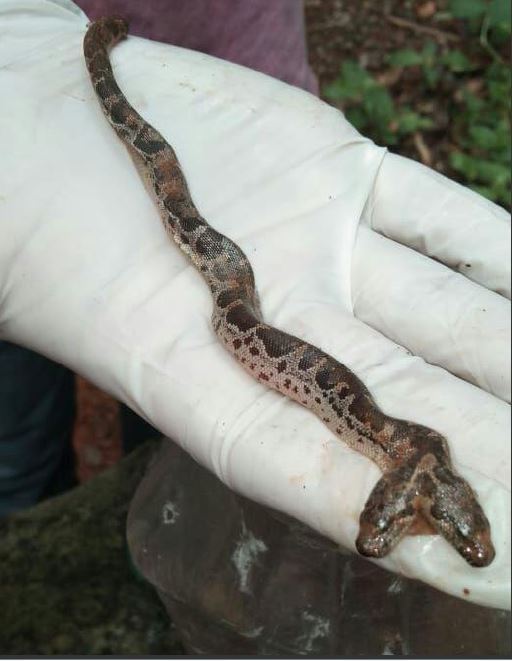A juvenile double-headed Common Sand Boa Eryx conicus was recovered from Meenchanda area (11⁰ 21’ 34”N, 75⁰ 79’ 96”E) of Kozhikode district, Kerala on 5 May 2019 by the Rapid Response Team of Kerala Forests & Wildlife Department. The snake measured to about 16cm and the two heads are almost equal in size. The snake was using both heads for perceiving objects around. All the 4 eyes were functional and it was protruding its tongue from both mouths. As it was not feeding naturally, egg (Japanese Quail) was force fed. The movement of the snake was always sluggish and after almost two months in captivity the snake died on 3 July 2019. Earlier, in 2013 a similar case of dicephaly in Common Sand Boa was reported from the Vatakara area of Kozhikode district (Palot, 2018) and this snake survived only for a few days.
Two-headed animals, due to their rarity and malformation, are a subject of scientific interest and curiosity. Many cases of dicephaly in snakes were reported from different parts of the world (Wallach, 2007). A detailed review on the two-headed snakes in India by Whitaker (1971) mentioned about records of two-headedness in Dog-faced Water Snake Cereberus rhynchops from Chennai city, Tamil Nadu; Checkered Keelback Xenochrophis piscator from Nagercoil, Tamil Nadu and Common Sand Boa Eryx conicus from Shimoga district in Karnataka. Further, Editor (1971) of the Journal of Bombay Natural History Society supplemented the note with the records of two headed Wolf Snake Lycodon aulicus, Indian Cobra Naja naja and Russel’s Viper Daboia russelii from India. Similarly, Mitra (1994) reported a case of newly born Russel’s Viper with two heads which lived for 23 days in captivity at Calcutta Snake Park, West Bengal. Subsequently, Acharjyo & Patnaik (1996) reported a two-headed Checkered Keelback from Odisha, but it survived for only two weeks. The above review reveals that the species with dicephaly normally do not survive long after birth. The maximum life span ever attained by a two headed snake was Black Rat Snake of America that survived for about 20 years in captivity (Mayell, 2002).
Acknowledgements
The authors are grateful to the Director, Zoological Survey of India, Kolkata, Officer-in-Charge, ZSI, WGRC, Kozhikode and the Divisional Forest Officer, Kozhikode Forest Division for facilities and encouragements.
References
Acharjyo, L.N. & Patnaik, S.K. (1996). Notes on Two-headed Snakes. Cobra. Vol. 25: 16-17.
Deraniyagala, P. E. P. (1958). A double headed Russell’s Viper. Spolia Zeylanica, 28(2), 167-168.
Editors. (1971). Journal of the Bomaby Natural History Society. 68(2): 462.
Mayell, H. (2002). Life is confusing for Two-headed Snakes. National Geography News. March, 22, 2002.
Mitra, D. (1994). The Birth of Double headed Russel’s Viper. Zoos’Print Journal IX (11): 22.
Palot, M. J. 2018. Occurrence of Two-headed Common Sand Boa, Eryx conicus (Schneider) in Northern Kerala, India. Cobra Journal. (In Press)
Wallach, V. (2007). Axial Bifurcation and Duplication in Snakes. Part I. A Synopsis of Authentic and Anecdotal Cases. Bulletin of the Maryland Herpetological Society. Vol. 43(2): 57- 95.
Whitaker, R. (1971). Notes on Indian Snakes-I. Journal of the Bombay Natural History Society. 68(2): 461-463.
Whitaker, R & Captain, A. (2008). Snakes of India. The Field Guide. Draco Books. Chennai. 383pp.
